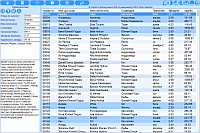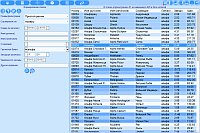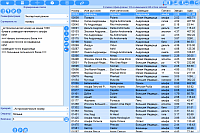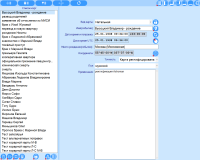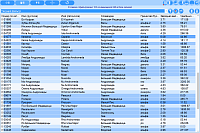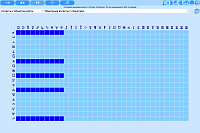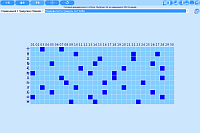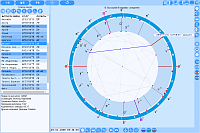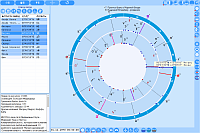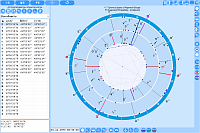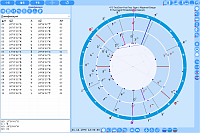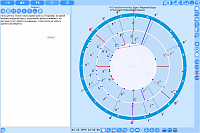as long as astrology exists itself. They are an integral part of it.
Many publications describe the effect of these celestial objects on a human and its life processes.
However, the stars have a rather limited use in modern astrology.
Probably, because at the present time there are few astrological programs that provide the opportunity to see the fixed stars in the horoscope; and there aren't any programs that allow you to see aspects from and to the stars with descriptions, giving the opportunity to qualitatively assess the fixed star.
, is designed to provide a modern astrologer with the tool for practical and research work with stars as astrological objects.
| Operation modes |
- Analysis of aspects to chart objects
- Analysis of conjunctions with Zodiac degrees
|
| Star selection mode |
- Static selection: star selection from the databases by different grounds when the original list for analysis is generated
- Dynamic selection: star selection during chart calculation depending on operating mode conditions, charts (events) and astrological tools
|
| Chart display |
- Single chart
- Pair of charts
|
| Supported planes |
- ecliptic
- horizon
- equator (1st and 2nd ESC)
|
| Supported house systems |
24 house systems, including - 14 of the most common and 10 modern |
| Type of Zodiac |
Tropical |
| Work with aspects |
It works with any aspect including mundane |
| Work with objects |
- Planets of septener
- Spiritual planets
- Lunar nodes (true and mean)
- Main fictitious planets and points
|
| Support of object display scheme on chart |
- non-displayed
- displayed
- with cross-aspects
- fully aspected
|
| Features |
- color scheme of a list of stars depending on category
- generation of final list grouped by chart objects or sorted by name, ecliptic longitude or number of stars
- Display of information on stars:
- astronomic number of a star in Bonner Durch- musterung catalog
- name (Russian)
- name (Latin)
- other names
- constellation
- letter in constellation
- star magnitude
- distance of star
- description
|
| Loading and saving charts |
work with unlimited number of databases and unlimited structure of bank |
| Calculation of time correction |
Considering alternative resources |
| Directory of populated places coordinates |
More than 16 ths populated places (in Locator program) around the globe |
| Protection of charts |
Chart data protection against accidental change |
| Support for CALIF and JALIF |
Supports full |
|
| Stars database. Stars in a list are displayed in different colors depending on the star magnitude: the darker the color is, the more significant (brighter in the sky) the star is. For each star the program shows the detailed specifications as a catalog number, the Russian and Latin name of the constellation, and the letters in the constellation, magnitude and distance, as well as alternate names and descriptions |
|
| Static selection (filtering) of a list of stars allows to generate a starting set of stars for further work. Stars can be selected by all characteristics existing in the database. The selected list can be further sorted, and selection criteria can be saved in the program for further work. The list generated as subset of stars is used in the program as a static set |
|
| Static expert selection (filtering) of the list of stars. This selection option allows you to create complex queries to the database to generate the initial set of stars for further work. It makes sense to use this kind of selection if an astrologer understands the essence of these selections or if a simple selection does not suit him. The selected list can be sorted, and selection criteria can be saved for further work. The list generated as subset of stars is used in the program as a static set |
|
| Entry of data for charts and events is the standard screen for all Galaxy programs that have the ability to create a list of charts and events. All events are presented as a list. Depending on the type of a chart you can enter additional parameters designed to automate the analysis process |
|
| Worklist of stars is a result of a static selection. Where you can specify and adapt a list of stars for the future work, as well as to check whether all the ephemerides of stars are on the computer to calculate the position of the selected stars |
|
| Screen of the conditions of stars dynamic selection: aspects to the chart objects. The conditions of stars dynamic selection are generated here. If these conditions match, a particular star from the static set will be displayed on a chart. If these conditions are not met, an star from the static set will not be displayed on a chart. Aspects to the objects of a natal chart or events will be checked if 'Aspects to chart objects' condition is selected. Here you can also create your own conditions of dynamic selection and save them for future work. Please, use the right mouse button on the table name to enable the conditions group |
|
| Screen of the conditions of star dynamic selection: conjunctions with Zodiac degrees. The conditions of stars dynamic selection which depend on a natal chart (event) and applied astrological instrument are generated here. If these conditions match, a particular star from the static set will be displayed on a chart. If these conditions are not met, an star from the static set will not be displayed on a chart. If ‘Conjunctions with Zodiac degree’ condition is selected so star conjunctions with a particular Zodiac degree will be checked according to the data of a natal chart or event. Here you can also create your own conditions of dynamic selection and save them for future work. Please, use the right mouse button on the table name to enable the conditions group |
|
| Screen of work with charts: the main screen of Stars program. The conditions of the dynamic selection are set: 'Aspects to chart objects'. A chart shows aspects from stars to the chart objects. Aspects of the current (selected) star are displayed in color, and the rest are in gray. This allows to highlight aspects of a particular star among a large number of other aspects. By mouse click on the chart object and aspect you can get information on the star, its position and aspects to the chart objects. Sorting is available in the list. Just click on the column title. The star cursor is displayed in the same color as the star points on a chart. Stars in a list are displayed in color, which depends on the star category. |
|
| Screen of work with charts: dual chart. The conditions of the dynamic selection are set: 'Aspects to chart objects'. A chart shows aspects of the stars in the secondary progression at the time of marriage with Marina Vlady to the natal chart objects of Vladimir Vysotsky. By mouse click on the aspect icon you can get information about the aspect. The star cursor is displayed in the same user-specified color as the star points (indicators) on the chart. The information on the current star is displayed from the database |
|
| Screen of work with charts: dual chart at dynamic selection conditions ('Conjunctions with Zodiac degrees'). In this mode the chart does not show the aspects! By mouse click on the chart object you can get information about a star and its position. The star cursor is displayed in the same user-defined color as the star points on the chart. The stars in a list are displayed in color depending on the star category |
|
| Astrological parameters of the chart objects on the multifunction panel. In this mode you can see information only on the main chart objects (excluding stars). Various display modes are available: a table of objects, 30-degree table, etc. To sort column, please, click on its title |
|
| The cross-aspects between charts objects. In this mode you can see aspects between the main chart objects only (excluding stars). The different display modes are available: aspects from compressed/full table to a table view of aspect chains. For extended information on aspects, please, click on it |
|
| Domification. A maximized table of rulership and position of cusps and rulers in the signs and houses is presented |
|
| Information on a chart. You can obtain additional information on the current chart. For example, cast time of astrological instrument |
|
| Time points. Time points mechanism allows you to quickly set the time of the chart or event. Depending on the setting, time points may vary in color depending on what chart the time was received from |
|
| Notebook is designed for annotations and notes in the course of astrologer's work with the astrological program |
|
| The algorithm to generate a stars set in Stars program.
Stars are filtered as through a sieve by means of the mechanism of static and dynamic selection. An astrologer gets for work only those stars that meet the given conditions.
|
 Stars (Galaxy.Stars) is a specialized astrological program designed to work with the stars.
The Stars are used in astrology as long as astrology exists itself. They are an integral part of it.
Many publications describe the effect of these celestial objects on a human and its life processes.
However, the stars have a rather limited use in modern astrology.
Probably, because at the present time there are few astrological programs that provide the opportunity to see the fixed stars in the horoscope; and there aren't any programs that allow you to see aspects from and to the stars with descriptions, giving the opportunity to qualitatively assess the fixed star.
Stars (Galaxy.Stars) is a specialized astrological program designed to work with the stars.
The Stars are used in astrology as long as astrology exists itself. They are an integral part of it.
Many publications describe the effect of these celestial objects on a human and its life processes.
However, the stars have a rather limited use in modern astrology.
Probably, because at the present time there are few astrological programs that provide the opportunity to see the fixed stars in the horoscope; and there aren't any programs that allow you to see aspects from and to the stars with descriptions, giving the opportunity to qualitatively assess the fixed star.